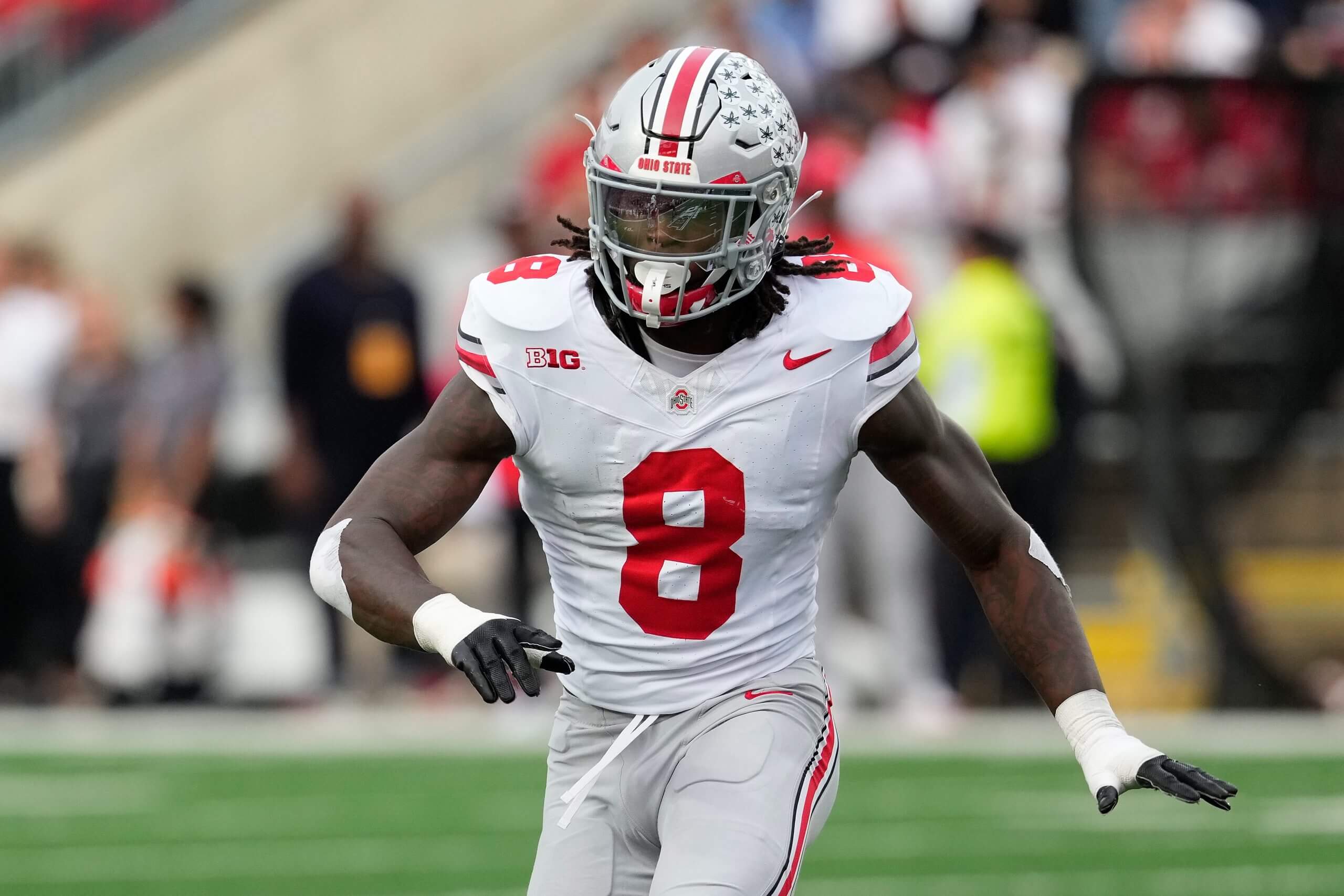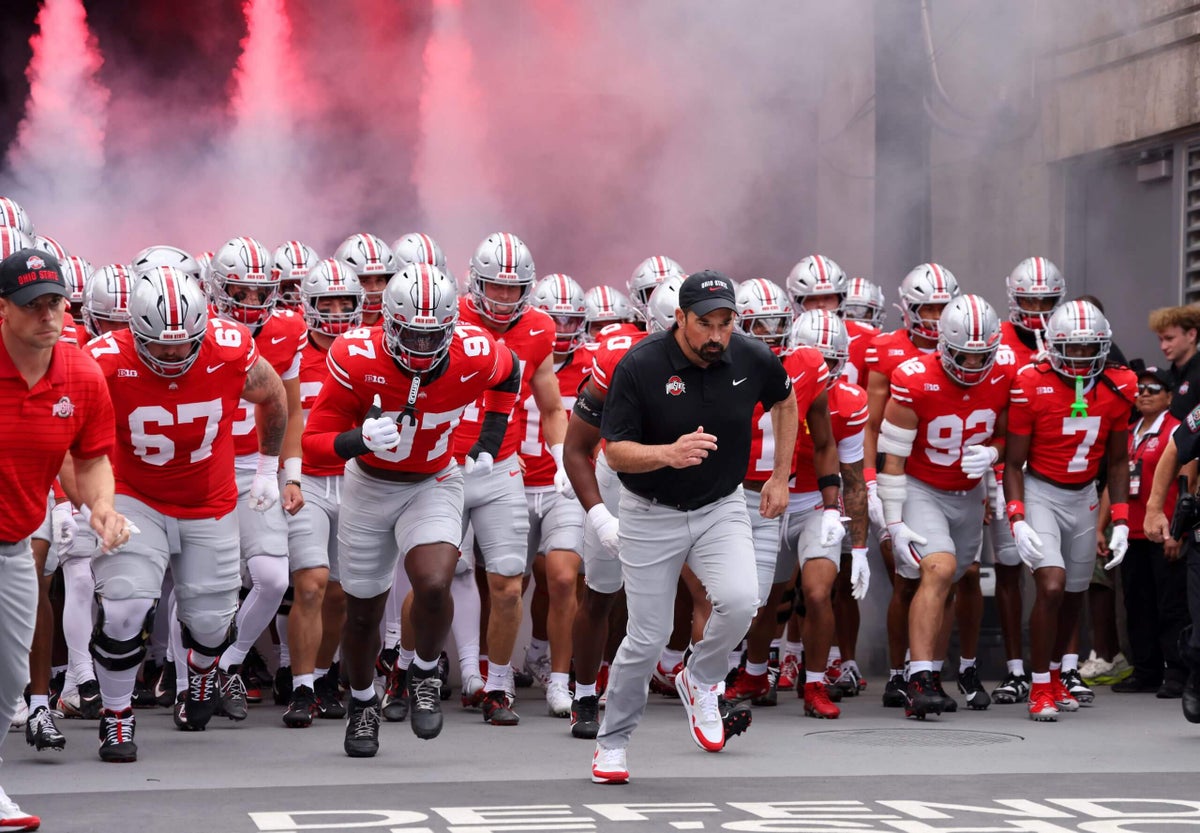COLUMBUS, Ohio — Ohio State has been atop the AP poll since beating Texas in Week 1 and has dominated its opponents, outscoring them 255-41 amid a 7-0 start, capped by Saturday’s shutout of Wisconsin.
According to projections from The Athletic’s Austin Mock, the reigning national champion Buckeyes have the best odds to win the Big Ten (50 percent), make the College Football Playoff (over 99 percent) and win another national title (22 percent).
So will Ohio State pull off a repeat despite losing 14 players in the NFL Draft?
The expanded Playoff could make a second run more difficult, as it requires more wins against quality opponents, and the Buckeyes showed last year that it could come down to the right team getting hot at the right time.
Still, in a fairly chaotic season in which Indiana, Georgia Tech and Vanderbilt are all in the top 10, college football’s most consistent winner might be the team to beat again. So let’s look at three reasons why Ohio State can win it all again — and three reasons why it might fall short.
Why Ohio State will win another title1. Elite red zone defense
It’s no coincidence that the past four national champions have finished in the top five in touchdown rate allowed in the red zone. Ohio State finished second last year (42.1 percent), and despite losing eight starters, it’s No. 1 this year (16.7 percent)
Ohio State rarely lets teams into the red zone, period — 12 opposing trips inside the 20 are the fourth-fewest — and when they do get there, they rarely put up seven points. The Buckeyes have allowed just two touchdowns in 12 red zone attempts, plus four field goals. They’ve allowed 2.08 points per red zone trip, more than a point fewer than any other team, according to TruMedia. Add it all up, and Ohio State has given up the fewest points through seven games of any team since 1993 Florida State.
Why is Ohio State so successful? A lot of it has to do with its size along the defensive line and its athleticism at linebacker and safety. It’s difficult to run on Ohio State, which has allowed just 19 yards on 17 red zone rushes (excluding sacks). And when opponents throw the ball, the physicality of the cornerbacks shows up.
It takes creativity, like Illinois’ fullback pitch to a receiver, to score in the red zone against Ohio State. The Illini remain the only team to score a touchdown in the red zone against Ohio State.
2. Julian Sayin’s efficiency (and targets)
Sayin is a sophomore in his first season starting, and he’s completing an FBS-high 80 percent of his passes. He also ranks second in pass efficiency (189.7), fourth in touchdowns (19) and seventh in yards per attempt (9.6).
Saturday was his best game yet. Wisconsin doesn’t have an elite defense, but the California native attempted a career-high 42 passes and completed 36 for 393 yards and four touchdowns.
Sayin has proven he can throw the deep ball — he has 10 completions over 40 yards, fourth in the country — but he’s not greedy and is fine taking underneath throws when they are there. His 13-yard touchdown pass to Brandon Inniss against the Badgers showed off his ability to throw on the run. He’s even throwing in the face of pressure, as he completed 5 of 8 passes for 50 yards and two touchdowns against pressure in that game.
Ohio State has a lot of faith in Sayin because of his poise on the field and the way he prepares during the week. A five-star recruit in the Class of 2024, Sayin might not be the Heisman front-runner right now, but he’s inching into the conversation in a wide-open race.
Elite quarterbacks don’t always equal championships; C.J. Stroud didn’t win one at Ohio State despite being a Heisman finalist twice. But this Ohio State team has a much better defense than Stroud’s teams, and it’s pairing Sayin’s accuracy and efficiency with Jeremiah Smith, Carnell Tate and the best receiving corps in the country.

Linebacker Arvell Reese has broken out as a top NFL Draft prospect. (John Fisher / Getty Images)
3. Ohio State has Arvell Reese. Other teams don’t
Safety Caleb Downs is the most influential player on the defense because of the calls and checks he makes in the secondary. But the way defensive coordinator Matt Patricia is using Reese at linebacker makes him a very close second.
Reese does everything. And does it all well.
He leads Power 4 conference linebackers in pressures with 19, according to PFF. Though some of those pressures come from blitzes, some are a product of instincts. He has 5.5 sacks, the most recent of which against Wisconsin coming because he was acting as a spy and felt the right gap to shoot once he saw the quarterback wasn’t moving.
He’s asked to cover running backs out of the backfield, has two pass breakups, leads Ohio State with 42 tackles and is the main spy because of his athleticism, which makes it hard for quarterbacks to get out of the pocket.
Ohio State has a lot of individual talent, but the success of the defense is because everybody does his part, including Reese. What makes the defense more difficult to solve is offenses rarely know what Reese is doing because he’s shown he can do it all.
Reese is a unicorn who has rapidly risen in NFL Draft rankings — he’s No. 10 in Nick Baumgardner’s midseason big board — and his ascension could propel Ohio State’s defense to another title run.
Why Ohio State might fall short1. Inconsistent running game
It’s not as if Ohio State is alone in its shortcomings; fellow contenders like Miami, Alabama and Georgia are below the 51st-ranked Buckeyes in yards per rush. But the past two weeks have left a lot to be desired.
In the 34-16 win over Illinois, Ohio State ran for 106 yards and averaged 2.9 yards per carry. Against Wisconsin, it ran for 98 yards and averaged 3.5 yards per carry.
But this is less about statistics and more about Ohio State’s inability to find the right balance on offense. Ohio State’s rushing attack wasn’t elite last season, as it finished 58th in averaging 166 yards per game, but when the Buckeyes needed to run the ball, they could dominate up front and lean on a pair of NFL Draft picks in TreVeyon Henderson and Quinshon Judkins at tailback. The win over Penn State was the perfect example: They didn’t throw the ball once on their game-clinching drive.
We haven’t seen Ohio State show that ability this season. The two-game stretch averaging more than four yards per carry against Washington and Minnesota was promising, but it hasn’t duplicated that success.
Part of the problem is the Buckeyes are a bit too predictable at running into heavy box fronts, which they expected against Wisconsin and therefore threw the ball 42 times. It didn’t lead to much efficiency on the ground. Forty percent of Ohio State’s rushes have come against eight-plus defenders in the box this season, according to TruMedia, the 11th-highest rate in the FBS.
This second idle week is going to be about finding the best rushing attack combination going forward. Freshman Bo Jackson has been good as the lead back with 433 yards and is averaging over six yards per carry, while roles have been reduced for expected lead runners CJ Donaldson and James Peoples.
Could another freshman move up in the rotation? Isaiah West was the most productive back against Wisconsin with nine carries for 55 yards. Some O-line changes could come, too.
2. Questions on the right side of the O-line
Ohio State’s offensive line has been very good this year, especially in the passing game. The Buckeyes have the second-lowest pressure rate allowed at 19.9, and Sayin has been sacked just three times.
Still, the right side of the offensive line has been a problem, especially at guard. Tegra Tshabola has started all seven games, but he’s split snaps. Early he was sharing time with Ethan Onianwa, and now Josh Padilla is taking snaps away. At Wisconsin, Padilla played 26 snaps and Tshabola played 43.
Ohio State will evaluate everything during the idle week, but Tshabola struggled against Wisconsin and has been inconsistent. He has the most pressures allowed with eight on 165 pass rush snaps, the least among the starters, per TruMedia. He gave up two pressures against Wisconsin and seemed to be out of sorts in the run game at times. Right tackle Phillip Daniels is second on the team with seven pressures allowed on 206 pass rush snaps.
Left tackle Austin Siereveld and left guard Luke Montgomery have been fairly consistent, but running left every time is not something Ohio State can do en route to a national championship. It has to find the best rotation on the right side to get the job done.
3. Special teams mistakes
Special teams has been a major concern of fans for years, including going into the Playoff last season after kicker Jayden Fielding missed two field goals in the 13-10 loss to Michigan.
There have been more issues this year, and not only from Fielding — who did miss a kick against Wisconsin but is 8 of 10 on field goals. The punt teams need work, as Inniss struggled on returns early in the season, even fumbling against Washington. Though he’s improved, the punt coverage has been inconsistent, too. On Saturday, Ohio State didn’t cover the punter as he ran for 20 yards to convert a fourth-and-19. Coach Ryan Day was not happy about it.
Look back to the loss at Oregon a year ago when the Ducks went for an onside kick in the first half, recovered, scored and went on to win by one point. Extra possessions can make or break a Playoff run, and the Buckeyes still need to button some little things up, even if most aspects of the team are looking championship-worthy.
